
The fourth succession planting is now maturing for next years seed stock. They don’t call then Snow Peas for nothing.

The fourth succession planting is now maturing for next years seed stock. They don’t call then Snow Peas for nothing.
“I’ve got an old mule and her name is Sal. Fifteen miles on the Erie Canal…”
Working on time warp here… seeing how far I can push my vintage lower ball joints while carrying cameras along portions of the New York state Barge Canal bicycle trail. Field photography comes with a price tag in arthritic pain these days, but it’s much milder on the bike where I’m good for a couple of hours over easy terrain. My range on my legs is only a few hundred yards.
It’s important here that I’m post processing on a newly resurrected quad processor game computer with much faster performance than my old machine. Weeks of hardware and OpSys work went into this upgrade. Great thanks to my son David Mutch for his old desktop.
The new machine allows me the time and HDD space to try numbers of variations on the same ex- camera – pixel sets. The duplication is on purpose, partly to explore when color really helps communicate and when it’s irrelevant. The heydays of the Erie Canal didn’t really happen only in black and white; it just seems that way because that is what we still have.
I’ll see if I can add comments to the individual pictures.
‘Nuff for now… Next Post: Not sure when.
I’d like to get in one more field expedition before the autumn passes me by completely.

#174 The B&W challenge Notes
Current pictures from reality; no people, no explanations. I simply did not have the time to do this challenge in its true spirit, on analog film … best of five, each day in order, on a 36 exp. Cart … develop, print and scan. I cheated, using my “C team” digital point and shoot, locked on B&W for small jepg’s. It’s an old Lumix w/ a 3:1 zoom, scratched front element and so flimsy as to be considered disposable.
Day one: 0541 The kitchen table, more or less visible for the first time in months after an entire morning sorting and cleaning. Chaos overwhelms.

Day two 0531 The same place the previous day after weeks of indecision, sorting, dating and germination testing seeds for this years garden. Abundance overwhelms.
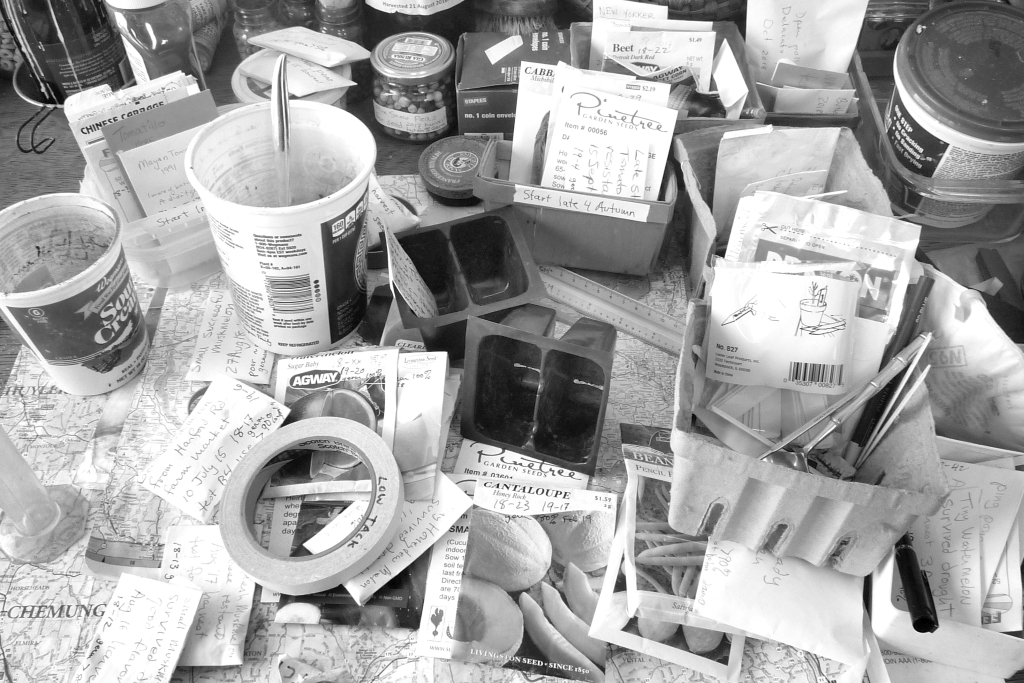
Day three 0544 I’ve been nearly twenty years in this house without handles on the drawers and cabinets. They require tuits. Tuit holes drilled thru the wood. Tuit pan head screws of the correct size and length, be they SAE threads or metric. The first attempt, a decade ago, required M4 x 5cm screws. No amount of local shopping would doit tuit. Then a lucky find at Finger Lakes Re-Use; a dozen lovely blue metal ones in SAE #8 x 1 3/4” and a dozen plastic that matched the formica of the counter tops. I finally got a round tuit ! Motivation overwhelms.
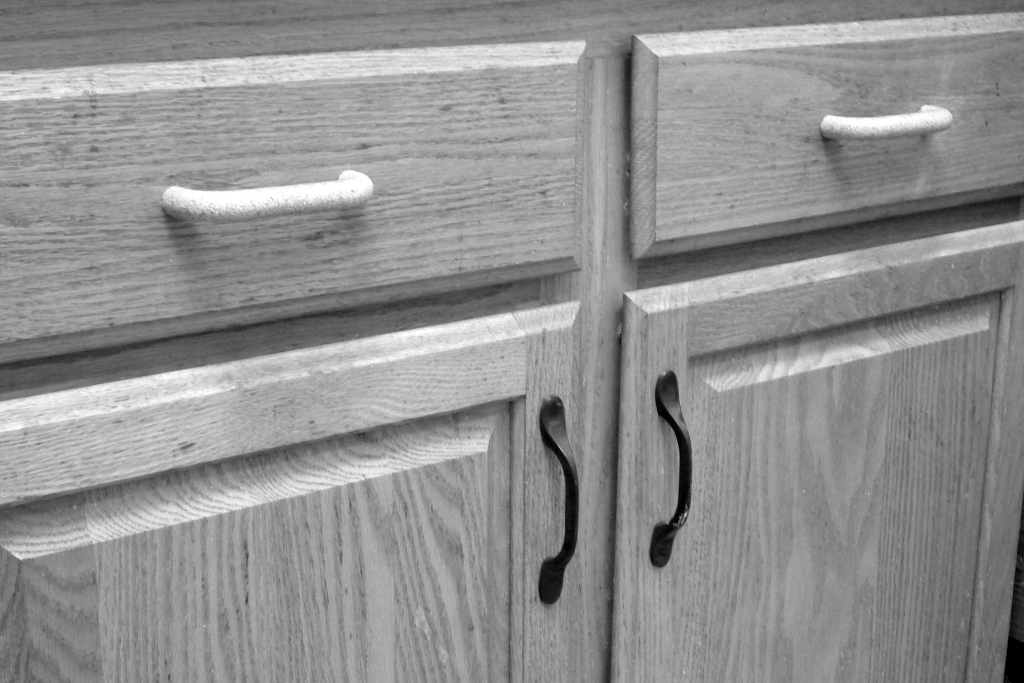
Day four 0524 The Higher Consciousness endows most of us with no more than two eyes and two hands. ? Whyfor, therefore, do so many cameras and lenses seem to accumulate around here ? Sheer stuff overwhelms.
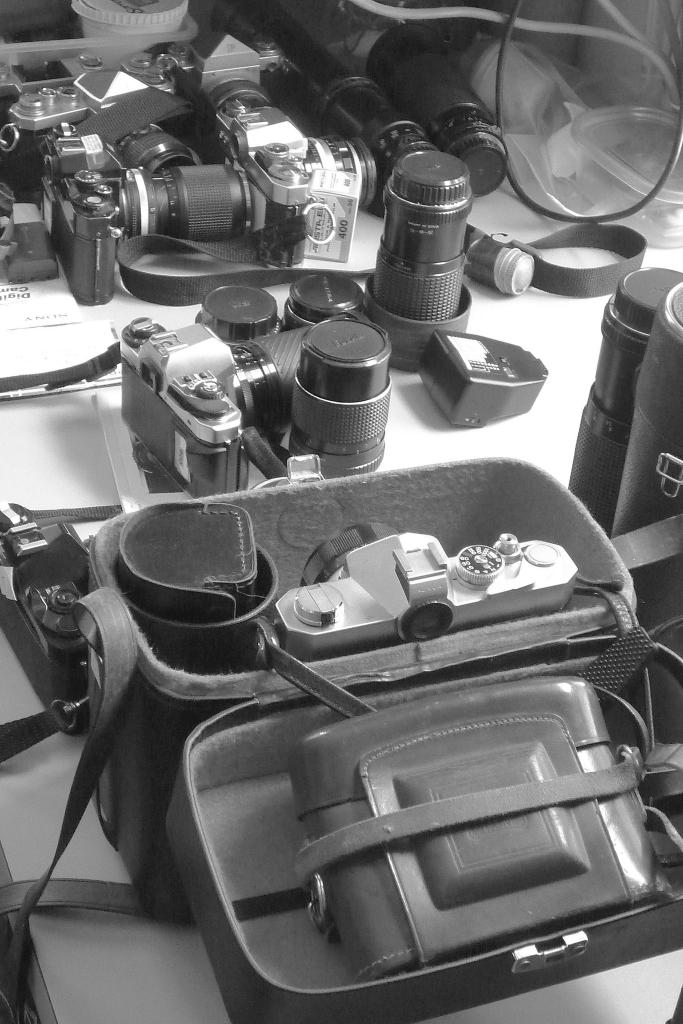
Day five 0555 Jungle Clearance Crew Portapotty. It certainly looks* like the contractor provided sanitation facilities for the crew. It certainly seems* like the contractor crew clearcut all the understory of the Norfolk-Southern RR land along Cayuga Inlet branches where the homeless “Jungle” camp used to be. It certainly looks* like there is no cover to hide the tents and no cover where the homeless didn’t have any sanitary facilities. It Seems* like they are all gone. I think* I remember that the homeless shelter downtown couldn’t cope this winter and changed management. If I were still a real* journalist I would have to go around and get a bunch of quotes … but if you ask no questions they’ll tell you no lies. Power overwhelms.
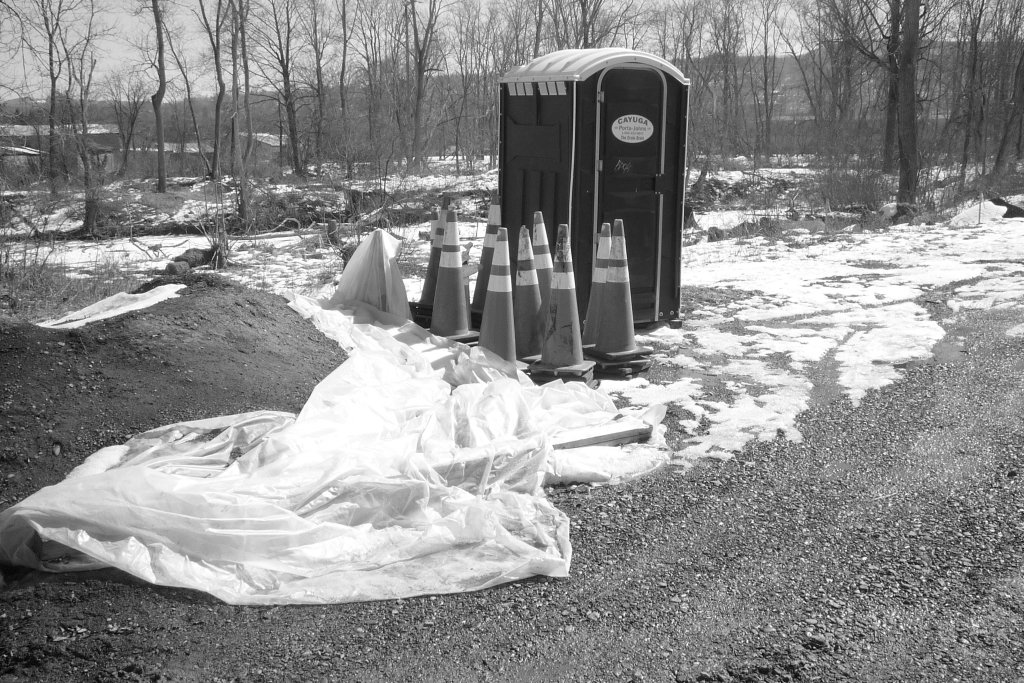
Day six 0521 Rage, Rage Against The Filthy Profiteering Software ! You don’t wanna hear all the details. Corporations Overwhelm. But it’s a bad business model that gets your customer to hate you.
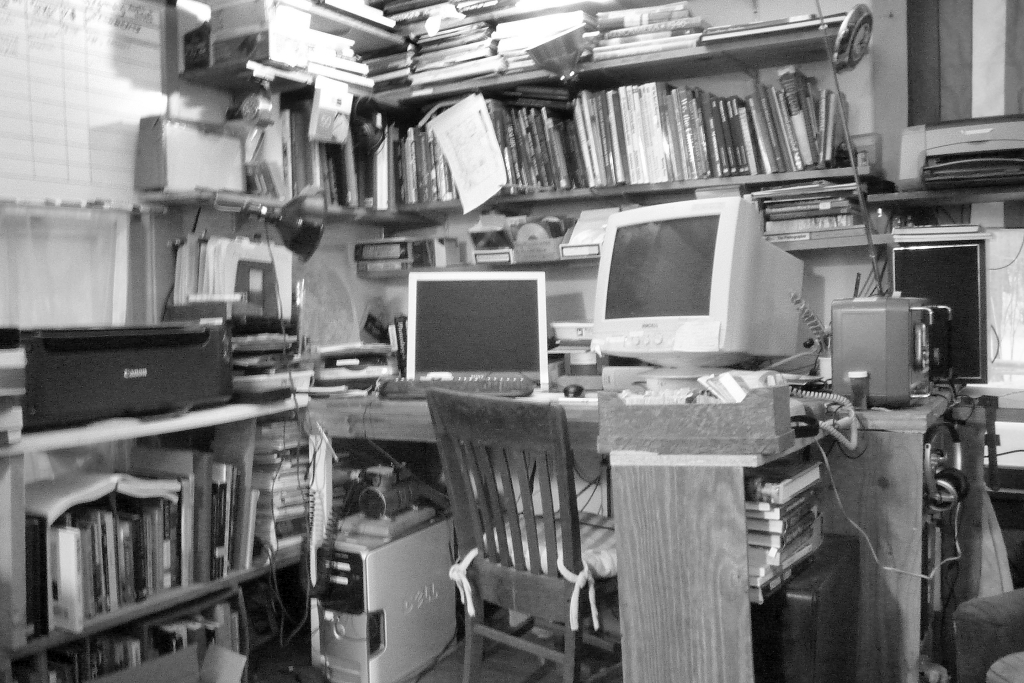
Day Seven 0518 Hello Jimminy Cricket. Publication and posting have been delayed a day an a half for avalanche damage control. A week or so after the photo, I’ m thrashing in a caveman dream, running from a mastodon that doesn’t wanna become mastication burgers when the entire Salvation Army bed frame disintegrates, throwing mattress, box spring, blankets, ten shelf feet of hardbound books and ME to the floor. I am shocked but un-injured. Now … what was I supposed to do yesterday ?? Entropy overwhelms.
Did you get the idea that I’m overwhelmed Seven Days a Week … a day short of a Lennon & McCartney lyric … I’ll sing a song of sixpence when I get caught up.

I just haven’t the patience to hassle with the HTML of formatting this all pretty, so
‘Nuff for now Next Post…not soon.

#172 A Small Portfolio Writ A Little Larger
This portfolio is much abbreviated as I want to show many fewer pictures, but larger. The entire portfolio for the eventual CD will have more than forty images made over 35 years. All were made with analog silver gelatin film; the earlier ones with Kodak H.S. Infrared, more recently with a German film marketed under the Rollie brand. Digital photography in infrared is possible but usually requires professional modification of a dedicated camera body and filter set.

I-483-06LetchworthOverlook01©MPS An image at first confusing as the infrared penetration of distant aerial perspective obscures the hundred foot drop-off just before my feet. Is it but an abstract ?
The graphic look of infrared photos can be quite dramatic and there are scientific, business and forensic uses which have carried the form forward into the digital era.
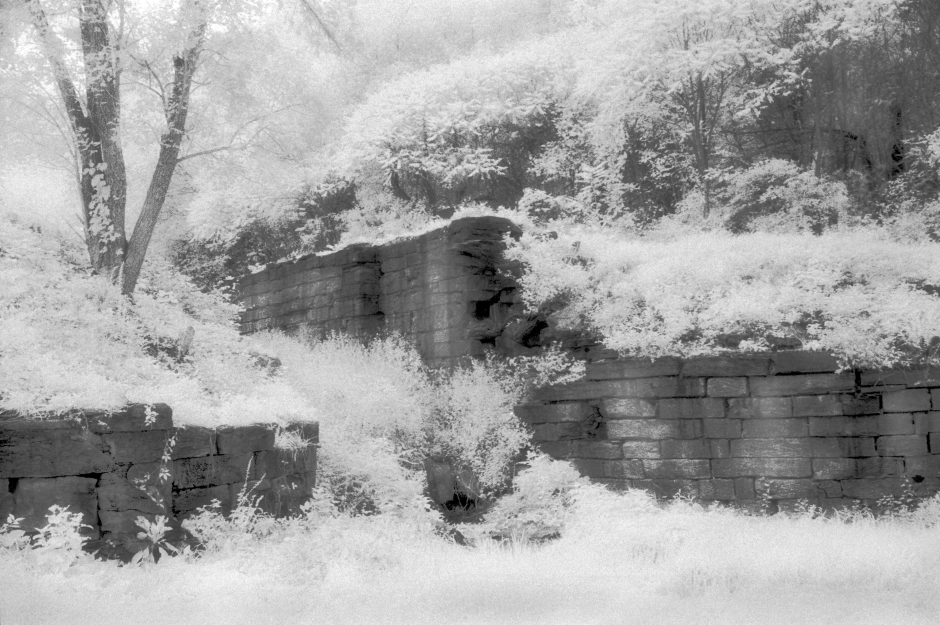
I-483-19GenesseeValleyCanalLock5705©MPS.jpg Infrared often renders stone well by its retention of heat. Useful for industrial archeology.
During the analog film era infrared photography presented considerable technical challenge. The film is quite grainy compared to panchromatic (visual light) films of comparable unfiltered speed. This limits the resolution of the film to poor levels by modern standards unless the negative is physically large. Filters to take advantage of the infrared sensitivity slow the exposure considerably, making action shooting challenging, and most photo lenses…even the best… have different characteristics at long IR wavelengths. Many materials have un-expected characteristics in the infrared transmission, absorption and/or reflection. The cloth focal plane shutters of the finest 35mm cameras were nearly transparent to the wavelengths of interest…as are many plastics that are opaque to visible light. Sometimes polished metals you’d expect to be reflective turn out quite absorbent of IR. A result is that LOTS of experience is needed pre-visualize an infrared image from the visible scene before the camera.

I-483-32 View From Bonnie’s Kitchen Window. In my memories of my cousin’s farm is the chill haunt of the Glen Coe massacre centuries ago that happened in a similar geo-topology. So lovely when at peace.
The photosensitive films are extremely touchy about optimum exposure and development. They have relative low dynamic range and there is lots of variation in the proportion of visible to infrared radiation in nearly all natural and artificial light sources. Exposure meters don’t give even ballpark readings. At first it’s just a guess…with some experience you get better. If you must try it…with an #87 filter on a 50mm lens try 1/75th sec at f/9 +/- 1 stop, bracket 3. Keep good notes. Process film normal minus 8%. Until you’ve got an acceptable film negative, digital correction in software is of no use.
Infrared photography descends from a time when photographers were expected to be quite knowledgeable about physics, optics, chemistry and mechanics as well as the arts of the subject matter.
That was before you could buy it from the Mind of Minolta.
I-650-09CRRNJ HighCrossingNearHamptonFurnace01©MPS.jpg The industrial base that built the railroad here is long gone.
I-650-33TimingTowerGoKartsOswego06©MPS.jpg
Often the very technical limitations that make film IR photography so difficult give rise to the strengths of the genre. What can’t be seen can in some way be shown* or interpreted graphically. The images often feel ghostly or ethereal as if windows to the past, the mythic, or spiritual.
Occasionally they find their way to showing visually what has previously been known only mathematically.

I-650-33©MPS Porter Mount Telescope Housing At Stellafane, VT. Infrared seems so appropriate here because of the importance of non-visual spectrum. Stellafane is the spiritual home of DYI astronomy. I earned the pilgrimage.
Sometimes these images are just, simply, beautiful.
Sometimes they look best to the past
I-785-05 ©MPS Sawmill sluice gate hardware at Batso Village, NJ. In service. Lumber to maintain the village is milled here.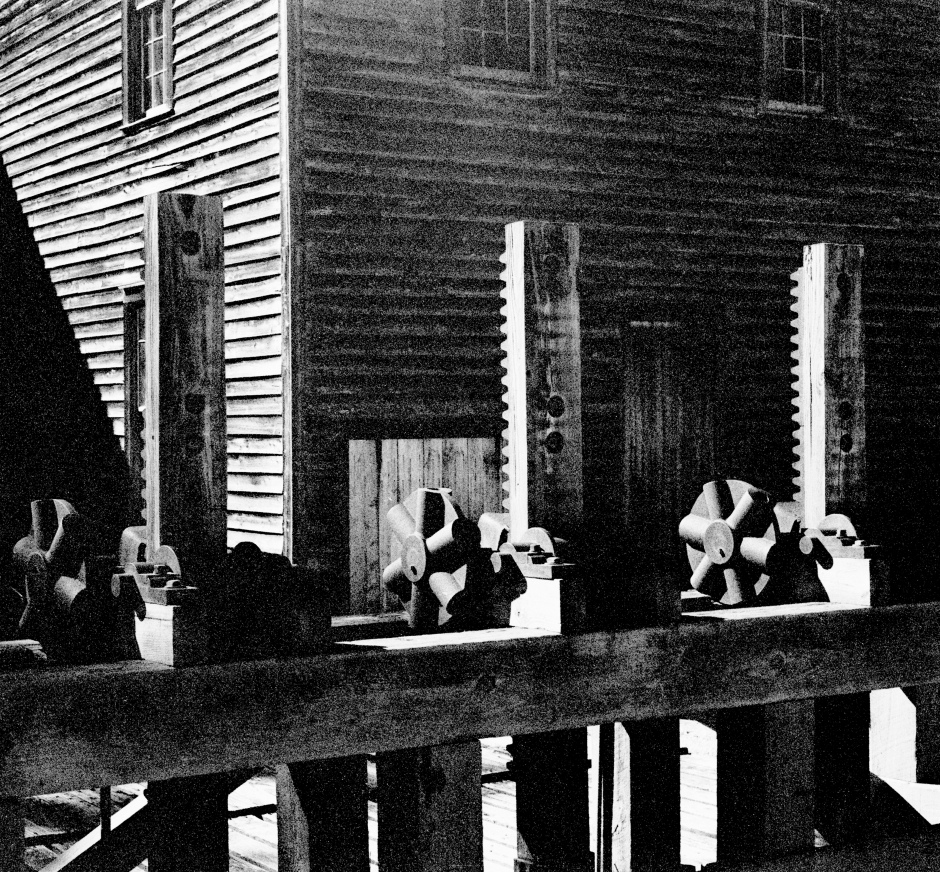
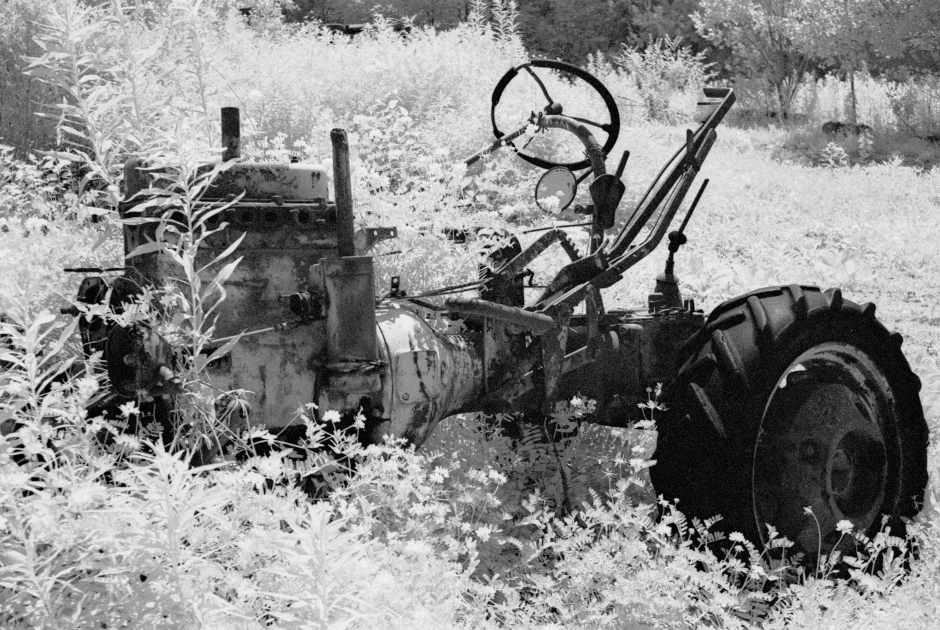
I-814-03©MPS Tractor repair parts. New Hope, NY. Not so lost in weeds, rubber tire quite absorbent as seen in IR
Sometime they show best what no longer exists but in the inner minds eye.

Wy-03-17 ©MPS 1958 Road to the Overlook Mountain House. Even before 1959 it was the hippy abandoned hotel of the Woodstock 1st generation. We climbed the mountain again, but it’s gone.
‘Nuff for Now…you wouldn’t believe how much work goes into these posts. Next Post: May be a while…lots to do before then.
#170 Fantasy Or Reality On One Axis; Recluse Or Pariah On The Other.
A post with more text than pictures. It divides in half. The most important half explores communications from my place along the recluse-pariah spectrum and how techie communications and its hardware and software relate to the concept “No man is an Island, entire of it self; every man is a piece of the Continent, a part of the main.” …(John Dunne) … which certainly causes me wonder these days.
About half a year ago I began to feel, in modern reality show parlance, “Voted Off The Island.” Not having a TV set I don’t know the show from which this derives, but in many social situations I’d come to believe that people really didn’t want me around unless I contributed substantially to their own prominence in ‘the Show.” I began dropping out of situations…don’t play music with others anymore, and find all kinds of reasons not to be in the social circles.
That has a lot of consequences; there’s difficulty in earning money…and one seldom knows what’s going on…or why. You don’t get the gossip, nor the hot market tips.
Feeling impelled to leave the island of the moment, it seems like the mode of redemption most available to me is to put to sea and find an island more welcoming. Putting to sea, to me, historically, has meant shipping as a radio operator on a U.S. flag merchant vessel. That means, in this day and age, that it’s a pipe dream, a mental escape, a fantasy. The U.S. merchant marine survives these days almost only as just a contract agent of the Department of Defense Sealift Command. Otherwise it’s mostly retrospect.
It wasn’t always. Our merchant marine manned the convoys of two world wars, from the WW1 Hog Island ships built in the yard at the current location of the Philadelphia International Airport to the Liberty and Victory ships modularly built for WW2 in shipyards on all three coasts. Between the wars our place in seaborne commerce was as good as it got anywhere.
“Whenever I find myself growing grim about the mouth; whenever it is a damp, drizzly November in my soul; whenever I find myself involuntarily pausing before coffin warehouses, and bringing up the rear of every funeral I meet; and especially whenever my hypos get such an upper hand of me, that it requires a strong moral principle to prevent me from deliberately stepping into the street, and methodically knocking people’s hats off – then, I account it high time to get to sea as soon as I can.” (H. Melville, Moby Dick)
“Just tell me old shipmates, I’m takin’ a trip, mates, and I’ll see them someday in fiddlers green.”
For as long behind me as middle school radio has been my “trans-silence,” my way to communicate when none other will work. It started with my buddy Johnny, three houses down the street, when we discovered there was no way you could get two-tin-cans-and-a-string quasi-telephone to carry our voices that far. Mrs. Adams, an intervening neighbor, didn’t want us to string wires through her garden, so we took to the airwaves and became novice Morse code ham radio operators. We both still are; K2PAS, de KC2LVQ, k.
In high school, before I found my true cohort of misfit nerds I spent endless hours in the attic hot wiring together radios to listen to the airplanes, right over my head, in the landing pattern for Newark airport. Only super-geek fossils will understand that it took a super-regenerative receiver with a #955 joint army/navy (JAN) ‘acorn’ (about that big) tube to accomplish that feat. I was ‘right there’ in the cockpit with the pilot… talking to Newark airport approach control…and yet, I was utterly alone in my mad scientist attic labor-a-tory under the thumb of Ming the Merciless.
6202Numb955AcornTube-©WEB
But marine radio is…and always had been, the “Senior Service,” as the Brits still call their navy. With the milestones of Marconi’s 1901 trans-Atlantic communication and other early pioneers, a fundamental change came to the world. Before that, by riding on the face of the deep, one disappeared utterly from the face of the land. The coming of radio meant the end of the communication isolation of ships at sea ! Yes, the old whalers could send a packet of letter home following a chance meeting with a homeward bound colleague; but with radio vast areas of the ocean became a huge Morse code party line. It was the first internet, using international Morse code with super-lingual agreed short ciphers so operators of differing mother tongues could transmit essential information quickly without error. Every merchant vessel of substantial tonnage had at least one radio operator monitoring the airwaves for distress calls, radiograms, weather forecasts, business gossip, news and entertainment. Each ship was no longer alone. “Radioman” was an officers paid job, though on itinerant freighters it was a lonely existence with odd hours dictated by sunspots, time of day, and weather. Somehow I became captured by my imagination of this life. At first it was vague; just a feeling of rolling with a ship under tropical twilight while listening with half an ear to call letters from Hawaii and never hearing my own. It became more real later when I had a long Morse conversation with a meteorologist, one of only three Canadians stationed on Belle Isle, a tiny, inhospitable rock off the northern most tip of Newfoundland. For that evening I was his only social contact with the outside world.
Getting serious resulted from needing money to start a photography business in New York City…where I thought * I should find my life. Here could I get that kind of money ? A little research disclosed that the Port of New York had illegally sent dozens of vessels to sea without the required radio officers because they were all employed on the west coast between San Diego and Cam Rhan Bay or the Saigon River, where a surprising number of merchant mariners ended up dead. North Atlantic shipping was offering attractive money for a nine month training contract. I started to seriously study for the exam, and took it during record August heat in a paint peeling GI office slum building in lower Manhattan. A Coast Guard LT-jg in sweat soaked summer whites entered my name and SS number in a PDP-9 data terminal that chewed for a minute and a half before granting me a low level security clearance. “OK you can take the exam.” If only they knew…
The theory and legal sections of the exam were easy to guess multi-choice questions, but the Morse code exam was no picnic. It required 5 minutes of random cipher groups at 16 words a minute…100% error free, and five minutes of plain language text at 20 wpm. I will never forget the message. “THE VOLUNTEER MUST BE 18 YEARS OF AGE AND HAVE A LAST WILL AND TESTAMENT PLUS CONTACT INFORMATION FOR NEXT OF KIN ON FILE WITH THE DISTRICT CHIEF ENGINEER. THE MISSION MAY INVOLVE SPECIALIZED TRAINING WITH EQUIPMENT OUTSIDE THE NORMAL OPERATORS DUTIES AND MAY ENTAIL HAZARDOUS CONDITIONS.” This to be written, by hand, at speed, in Federally approved block lettering, all caps.
The LT-jg looked it all up and down. “OK. You passed. Ten bucks, please. Paperwork clears three to six weeks.”
The fantasy became a little real. I’d actually become a T-2 radioman, ’Sparks’ , a ‘Lightning Slinger’ in the U.S. merchant marine.
A trip to the union hall on 8th Ave. and some voice-phone calls revealed a Catch-22. You could get a union card with a letter from a shipping company offering a job to a trainee T-2 radio operator, but a T-2 radio Op couldn’t get a job without a union card. You needed a T-1 for a sponsor and a months grocery money. I might have raised the initiation fee, but I didn’t know anyone who was T-1. The fantasy got a lot less real and life moved on.
There came other times when there was no one to talk with in the normal world and I took soles in voices and ciphers trickling down antenna wires from the airwaves. “The Ether,” it was called then.
There were nights between the headphones listening to a Cuban clandestine Morse station coding about international harvest guest workers, and every week I translated weather broadcasts into a visible map to learn what all those numbers actually meant to the guys on the vessels bridge. How hypnotic were those voices. There was Thor Heyerdahl on KonTiki with his battery operated NC-183, surviving whatever the Pacific could throw at them. (I didn’t hear that one.) There was Freeman Lang, KH6AX, at his post on the Honolulu docks keeping small craft aware of a Tsunami alert. The alert was cancelled with nine minutes to spare. He might have died on duty. A small group of friends once sat listening to the International Red Cross and shadowy US quasi-military units at the borders between two central American republics arguing about who could use the frequency traditionally occupied by Nicaragua. We heard, live and in real time, how Vatican Radio, with half a million watts power from HCJB in Quito Ecuador, would out-shout the US CIA and allow traffic from the Red Cross.
Over the years I’ve gradually climbed the totem pole of shortwave radio ownership from a Sears 3 bander I reconditioned as a project with my dad, through a fire damaged Hallicrafters DX-28, (top of the line in its day) then up the price list of the National Radio Co. to my current listening post of a Japanese made solid state TS-440s and my reconditioned vacuum state Radio Manufacturing Engineers 1943, a hamfest find.
Always one looks for a better radio…though, as Jody Foster’s character, Dr. Arroway, said in the movie Contact, “I’m gonna need a bigger antenna!” For some years now my aspirations have wavered between a Technical Material Corp. GPR-92 and something genuinely maritime, like a Radiomarine Corp of America AR-88, or a top line Eddystone, a Racal, or maybe the sexy! Canadian Marconi CSR-5. This is called “coveting Things.” Guilty as charged.
Audiophiles usually know the H.H. Scott moniker on fine high end stereo gear.
Long before that, in the 1920’s to 40’s, Earnest H. Scott designed and built the Rolls Royce of tube radios, culminating in the magnificent 30 tube “Philharmonic.” I saw one once…the chassis made MacIntosh stereo amps look a little shabby.
A few weeks ago at the annual Elmira, NY, hamfest, bait was dangled; I bit. Here was a genuine E.H Scott, right in front of me, model SLR-M, standing for “super low radiation – marine. The price was a weeks groceries, plus a six pack and pledge not to screw it up with a half-vast restoration.
This radio came to be called the “morale receiver” during and after World War Two. Merchant shipping traveled under the strictest radio silence in a North Atlantic infested with German U-boats. German radio direction finding was so advanced that the local emissions of normal radios could give them bearings to bring the U-boat wolfpacks to convoy blood, so JAN procurement contracted with E. H. Scott to produce these low emission radios. The Liberty and Victory ships could then at least listen harmlessly. Morse code was then still a living language. The SLR-M could receive it. Canadian Forces Halifax (CFH…nightly into the 1990’s) even sent literature readings and low propaganda news broadcasts in Morse. However, the main function of this model was to provide convoy info for the skipper, and music, entertainment, and news for the crew. It had fairly powerful, clean audio that could be wired to the wardrooms and mess decks.
Ah, Mom…it followed me home.
Down on the basement test bench it was fairly ugly, and I was very aware that this was an important artifact in our nations history. For the first weeks all I did was to clean it, slowly and carefully with tooth brushes and Q-tips. Five of the vacuum tubes were N.F.G. and the power wiring deadly; deteriorated. The celluloid dial was nearly opaque from age and the anti-backlash tuning gear train frozen with solidified lubricants.
Cleaning and adjusting these took days because the parts are irreplaceable. Some-one * had put thirty amp fuses in where the specs called for 2 amps…a wonder this never fried some irreplaceable component… and I blew half a dozen of the right ones before discovering that safe operation really did require upgrading the power supply to modern code with a hefty isolation transformer for 3 wire grounded AC. This took a couple more weeks, some other new parts, and doubled my financial investment. That accomplished, the radio came slowly to life, and with it my admiration for its design.
A good marine radio must be extremely robust AND repairable at sea. The manual even gives instructions for jury rigging replacement tuning coils following catastrophe. Every single part is specified (the radioman was expected to keep some of each in stock.) and the chassis reinforced so that the concussion from firing a 5” naval gun overhead will not upset the alignment of the circuits. All of the capacitors are either silver/mica or “bathtub” types of high reliability…for decades. (No one seems it know what’s inside a bathtub capacitor. Has anyone ever seen one that failed ?) I mean…this thing is BUILT !
This is not to say that the radio is super performance by today’s standards. It cannot separate densely spaced Morse stations, easily cope with single sideband signals, nor avail itself of digital signal processing to pull the very weakest cipher groups out of noise. But what it does do…it does very well. It listens well…it sounds good. The original spec loudspeaker is no slouch even today. When I reached the final re-assembly and alignment I discovered that even ¾ of a century later…almost as old as me…by (dare I say it) carefully following directions… it’s possible to dial in a station on a known frequency and just hear it without further search. For an analog radio that is amazing.
Another part of what makes this radio so satisfying is that it’s resurrection is positive proof that I honestly earned my rating. Hands on, I am still* qualified to be a radioman T-2 in the U.S. (1970) Merchant Marine. It’s an occupational specialty that no longer exists…The U.S. phased out Morse code in 1986 and my ticket expired four years later…but it isn’t…even today…totally a fantasy.
-30- file ends
‘Nuff for now: But remember…”Real radios glow in the dark.”
Freeman Lang at his Honolulu post about nine feet above mean high water with a tsunami inbound.
Next Post: who knows when ?
Any adverts for political candidates appearing with this post are here against my express wishes and do not represent my opinions or recommendations.
 Any adverts for political candidates appearing with this post are here against my express wishes and do not represent my opinions or recommendations.
Any adverts for political candidates appearing with this post are here against my express wishes and do not represent my opinions or recommendations.
Any adverts for political candidates appearing with this post are here against my express wishes and do not represent my opinions or recommendations.
#169 Tommy Got Home
The beacon on the home field…well, sortta. ? Have you ever remarked that while marine beacons…lighthouses…are all different so there can be no mistaking their identity and location, but all aerobeacons are all the same…white and green, rotating. Anyplace you can land a plane safely makes a good landing…wherever it is.
Tompkins county airport, these days. The actual home field was downtown where Ithaca’s Cass park serves today. Tommy, the Thomas-Morse Scout trainer S4x of the U.S. Army in The War To End Wars (WWone), would actually have come home there. The decade and a half long effort to return an airworthy Thomas-Morse Scout to its home town of Ithaca, NY, had little choice but to culminate here.
Light breeze from NW, 4/10 broken clouds up about 2500′ Clear aloft. Visibility greater than ten miles. Weather conditions, ‘iffy’ earlier in the day, were absolutely perfect !
Locals had nearly saturation media coverage of the flight in the month before. Suffice it that after a decade and a half of restoration and a couple of successful test flights, the restoration committee wanted to show off the prize bird for all the supporters of the effort and to the general public in one final flight before the irreplaceable airframe went to permanent display in the new historical society museum.
Those aviation fans from away can read a great deal of the story at these two link sites. Also check Wikipeadia.
https://www.facebook.com/tommycomeshome
Bring Tommy Home: ITH Hosts the Centennial Flight of the Thomas-Morse Bi-Plane
The U.S. Army flying service, later the Army Air Corps, later the U.S. Air Force was represented at this ceremony by the Civil Air Patrol, a uniformed civilian search and rescue auxiliary. “Hey Bird Dog get away from my Quail.”
Area antique auto enthusiasts put on a fine show including this blazing REO touring car owned by a local Trumansburg couple. It’s AAA membership appears to have been contemporary with the car itself and with the centenary of Tommy’s original flights.
The rollout of the restored aircraft was a mob scene where the viewers surrounded the craft as tightly as one imagines the French surrounded Lindbergh’s Spirit of St. Louis in Paris. Those patient enough could get close enough to see any details.
Some even touched it.
The band played marches.
a7086 Dryden Marching Bassoon ©WEB
There were speeches.
a7093 Prime Movers-©WEB
The ground crew pushed the bird out the taxiway and went through a complete pre-flight inspection one more time. This is probably the only airworthy Thomas-Morse in the world…it would be a shame to lose it for lack of a safety pin that should have been triple checked. The pilot would also be annoyed. The engine need to be run up to temperature before flight.
This aircraft has a bizarre monster for power, a Gnome 110hp Rotary engine. Instead of the cylinders and crankcase being attached to the frame and a crankshaft transmitting the power of the pistons to the propeller, this design dinosaur fixed the crankshaft to the airframe and spun the cylinders, massive crankcase! and prop together, out front. That produced a huge gyroscope effect giving the plane a great and dangerous reluctance to turn left. Only a few pilots remain alive who have ever flown a rotary. Ken Cassens got the job, sort of by default. The crankcase, cylinder assembly had to be hand turned so that each of its cylinders could be individually primed before attempting to start. Amazingly, it did. It almost settled into a steady idle, but died and required once again to “pulled through” and then heaved on by a large strong ground crewman.
The CAP deployed a line of guards to keep spectators at a reasonable remove from the taxi path. The crew manhandled the plane to the far end of the grass strip. It revved up. They tinkered a moment until the engine gave a full throated roar, and then…let her rip ! The takeoff run was very short, as one expects of wood and fabric bi-planes.
Once airborne the pilot treated the crowd to quite a few passes at medium and low altitudes before making three passes in the landing pattern. It was as if no one really wanted the flight to end, but eventually Ken Cassens maneuvered to a place just low and slow enough off the port side end of the grass runway to grease in for a perfect landing. Ground crew helped position the plane by the taxiway under its own thrust. And shut it down. What a moment it must have been for those who’d been with the project from the first.
After the successful landing the crowd quickly thinned, making it easier to really examine the plane.
Some of those closely involved were clearly in a state of afterglow. There were quiet conversations. Some had dreams…or plans.
People drifted away but not before I noticed the viewers had been almost entirely European, three or four clearly Asian faces, a couple perhaps Hispanic. I saw only one black man. He rode away from the ceremony on a bicycle. The Wright brothers and Glenn Curtis tinkered with bicycles. ? Was that lone black man the spirtbird representative of the World War Two 332nd Fighter Group ? The ‘Red Tailed Hawks’ ?
-30- file ends
Prints from this post will NOT be for sale as I have no releases from persons pictured. Just consider my pictures to be part of my contribution to the celebration.
Nuff for now: I’m exhausted… this is the longest post I’ve tried yet. Next Post: In the pipeline is a post on the restoration of a WW2 marine radio. Parts are on a UPS truck somewhere…it may be many weeks before the project is ready.
#168 Lisle Car Show
From the same wellspring that made me realize that while I’m surrounded by tofu entrepreneurs hawking ersatz ice cream, I truly come from a land-in-time of meatball Italian submarines, where, at least if you’re white and prosperous, the USA Rules !
The Mon’claire Mercery (sic) was as cool as it got…until you were ready for a pink Cadillac or a black Lincoln Continental.
They tell me that these days a lot of high school kids only bother to get a drivers license because they need an ID to get thru the door to the dance floor. Towns now have parked bikes where anyone with a smart phone can use them. I even know an ace car salesman whose bicycle cost more than I have ever* paid for a motor vehicle. It seems that cars are now the root of evil, burying our cities in spaghetti heaps of concrete, sucking the nectar from the deeps of the earth and spewing the raw materials of death into the everywhere air.
It wasn’t always so: Daimler and Benz may have started the wheels a’rolling, but America surely did become addicted to the open road…and the traffic jam.
Remember…
“What’s good for General Motors is good for America.” It wasn’t always true…of course…but when we emerged from World War Two, claiming victory as the nation least devastated…never mind the twenty million Soviet civilian dead who rolled up Hitlers master race under the ice of winter…our huge production of petroleum and ball bearings combined with a generation of veterans who’d grown up turning wrench time tinkering with jalopies into transportation. It made the car Our Kulcha.
I won’t deny my name. It’s mine as well. If you don’t understand who you were, you’ll never understand who you are. The car meant you could drive away from holiday vacation enuie in one state, zip to a seasonally deserted Cape Cod B&B and be back in time for the New Years blast. You could find hidden valleys unknown to street cars. Everyone at least tried to catch the submarine races. You didn’t have to know how to read a railroad timetable upside down or make four connections on the buses to get to the other side of the county. You could go when you pleased*.
Well, maybe it did get out of hand. The corporations that built the Detroit iron took decades to realize they’d been thumped by former WW2 axis enemies who made more sensible designs and built them with quality control that gave them twice the life expectancy at lower prices. Still….
I was on my way to somewhere else in my 300K mile, 23 year old import when I spotted a bevy of shiny iron with open hoods…a classic car show put on as a fundraiser for the volunteer fire company of the little hamlet of Lisle, NY, suburb of massive Whitney Point , which you may know only as exit 10 in the interstate. Something made me stop.
Looking around I realized I was in the landmind of the fanatics…and I understood *
I mean…just the Paint Job !
Some of the gearheads seem to have a few screws loose,
But then, there are some who really hold on to some values that we maybe ought to keep,
like this guy,
who borrowed his dad’s car for a date, borrowed it again to take the same gal on their honeymoon, returned it, and then restored it when he inherited it decades later. Still got the car…still got the gal.
There was something hard to deny about the feeling you could get by punching the pedal hooked to a big V-8
Some of it had to do with just the snarl and snort of all that POWER.
You had to put in a lot of paycheck and Someone* had to do the wrench time…I’ve done a fair amount myself after the inspiration of the Roadmasters Hotrod Club of my home town. McGlashan ? You still make ’em go FAST ?
Those guys would have loved the green monster in the foreground and might have chopped and channeled it before spraying that luscious color. The British invasion of the MG-TD came quite a while before the Beatles and the Rolling Stones. There was a little German bug here somewhere, too.
The show car guys are not without some sense of humor.
But we have to remember the reason for this show…
A little village can have a hard time raising the money to field a real public safety organization, but really need it, even when they are all volunteers, so…
The chief’s wheels might not be the latest.
But some neighbors will pitch in
And when the big horn blows the American iron will go where its needed.
‘Nuff for now: Next Post: Who knows when…
#166 Prints From the BOX – Part 2
A first selfie shows up in the near x-ray region. Long aftermath of childhood football collision that pulverized my nose. Later, a massive sinus infection took a few years to bring under control. I have the negative, though it might be hard to put a hand on it.
This one is just the other way around. Only extant is the proof sheet, a whole roll from the 645 Nettar of my college yearbook work. There are a couple of prints to remind me of that period of incarceration.
Crappy pictures here with two exceptions: The microscope from Bio 101 still moves me because I took my written notes and drawings seriously as scientific illustration and part of the learning process. At the time, with that camera and my understanding of practical photo technique I was light years from being able to do microphotography. The frame with the red arrow was the steps and Doric entableture of the Government and Law Department around whose frieze was cut, in stone, “IS IT NOT LAWFVL FOR ME TO DO WHAT I WILL WITH MINE OWN?” It struck me as somehow wrong then…and still does. The frame with the red arrow will make its importance known later in the post as well.
Here are a couple of places whose importance is that they no longer exist as they did then.
Both locations have become “upgraded,” condominized out of existence. Howard Beach was a lower working class neighborhood at the end of the subway line to Far Rockaway, for a while famous for the virulent racism that sometime goes on in such ‘hoods. It was distinguished by the outright love the residents had for living on the water.
I loved it too. Today it is manicured.
Just a little distance from the century and a half old resort area of Cape May, NJ was once…not that long ago…open rural land where people homesteaded…raised corn and chickens and kids. These days you can’t get within two counties of this site without running into real estate prices that ain’t chicken feed. I’d have loved living here. Nothing is quite so sure as change.
Here’s a frame that just establishes that I’m not a complete Luddite; there are some aspects of digital image technology that I like. The point of the picture is the huge messiness of many marine scenes. They are seldom tidy, shipshape, nor Bristol fashion.
For many years I tried in the darkroom to get a ‘singing’ print from this negative. It still exists…I just couldn’t print well enough to cope with the extreme dynamic range of the negative and the analog manner in which reducing picture contrast left me with either the central dark rectangle dropped into the depths, or the highlights blown out, or complete mud that no amount of dodge and burn seemed able to cure. A really good hi-res scan of the negative yields me a print file that, after lots of ‘turd polish’ can make a print that actually says what I wanted to say. You had to read this here.
Two more survivors from the Nettar 645
At the very earliest times of using the camera as a tool for exploring the world, the world was very new to my visual thinking. Each venture could produce a sense of wonder, of excitement, of risk even. A trip on the IRT Subway in NYC was an adventure ! Staring at the light coming through the alley between two buildings was a revelation. The Subway picture captures, for me, and still holds, the sensations of stink…ozone and sweat, foul air and the thunderous DIN when the express roars through. The diffusion/flare from the uncoated (pre WWII) lens of the Nettar told me somehow that for this frame…just this one maybe…not to worry about convergence of verticals…they didn’t even have to BE vertical…in fact the whole frame didn’t need to be rectangular, nor even symmetrical ! I’ll print it that way once…just this once. Why do we lose that sense of adventure in risk ?
Here’s a last little risk before moving on. It opens a HUGE ball of wax.
A basement corridor after school. I’m not sure of the identity of the guy leaning on the lockers. I have NO clue of the girl. Her face is in shadow. I’ve pointed my optical snout into what seems to have been, long ago, a significant and private moment. The legal situation regarding pictures of people has become outright Byzantine. Once, the basic principle was that one could legally photograph anything they could legally see. The legal question came up with what one did with the picture as realized ‘hardcopy’ in the real world. There were ways of dealing with invasions of privacy and of newsworthy events, pictures relating to national defense and proprietary processes. There was also the prohibition by cops on the beat who might, and sometimes did, beat on you. Decades of precedent law accumulated willy-nilly court until judgments in six and eight figures appear that defy even UN-common sense. A lawsuit in France awarded a photographer a quarter million dollar penalty for infringing on another’s ‘style’ by marking his contact sheet with a red grease pencil mark ! A whole school of ‘eye-candy’ photography has grown up that allows no subject capable of hiring a lawyer. I have no release to post this picture of people from 60 years ago. In some sense those people no longer exist. ? Do they ? Of course in SOME sense they do. I have to post the picture to establish that there was then an understanding of the need to look ! Who knows what was actually going on? There is something in the legal morass called the ‘doctrine of just and fair use.’ I so claim.
‘Nuff for now The next post was to be a third installment of Pix From the BOX. I’ve decided to cancel it because many of the frames I wanted to use are personal and identifiable enough that getting permission to use them would just involve more hassle than an old Hasselblad is worth. Until next time…whenever that may be.